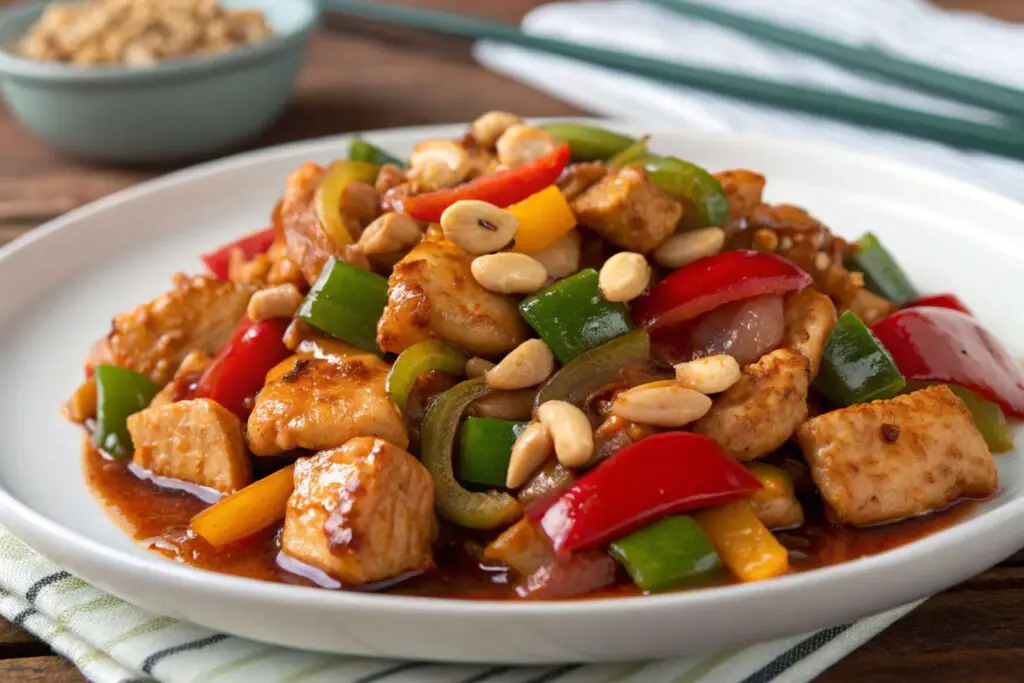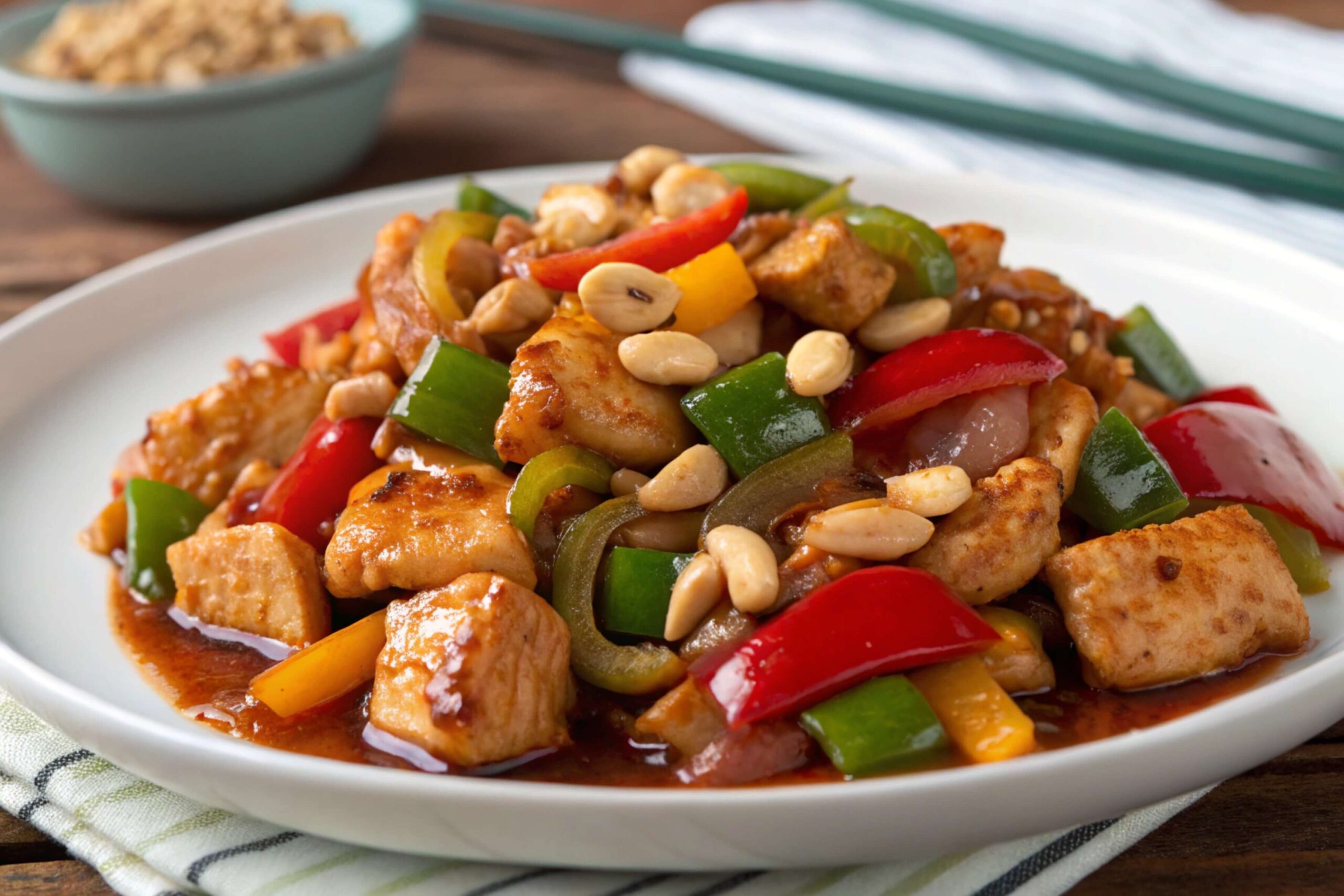want to listen to the recipe ?

Have you ever tasted something so good that you just couldn’t get enough? That’s how I feel about Kung Pao Chicken! This dish is a favorite for many, and it is easy to understand why. It has that perfect balance of sweet, sour, and savory with a little tingle of heat that keeps you coming back for more. Many of us enjoy ordering it as takeout, but what if I told you it’s easy and fun to make at home? While it’s often considered an authentic Chinese dish, the Kung Pao Chicken we know is usually a Westernized version. In this post, we’ll explore everything about it, from its origins to how you can make it in your own kitchen.
What is Kung Pao Chicken?
Let’s start with a little history. Kung Pao Chicken comes from the Sichuan province of China in the early 1800s. Interestingly, the traditional dish is a dry stir-fry. This means it does not have a lot of sauce like many other stir-fries. What we typically eat outside of China is usually an adaptation.
The flavor of Kung Pao Chicken is what makes it so special. It has a strong flavor profile that is sweet, sour, and savory, with a unique numbing heat from Sichuan pepper. The combination of these flavors creates a dish that is both comforting and exciting.
Key Ingredients in Kung Pao Chicken
The right ingredients are essential for a great Kung Pao Chicken dish. Let’s dive into the key components:
- The Chicken: I prefer to use chicken thighs because they are juicier than breasts or tenderloins. You can use chicken breast, but I recommend you tenderize it first, using a technique called “velveting”. This keeps the chicken moist during cooking.
- Sichuan Peppercorns: This is the ingredient that makes Kung Pao, well, Kung Pao! It has a unique, lemony, numbing spiciness that is different from typical chili heat. I prefer using pre-ground Sichuan peppercorns for convenience. If you like, you can grind whole peppercorns, but be aware they can have a gritty texture. Also, remember to taste first, as spiciness varies. If you can’t find Sichuan peppercorns, white pepper is a good substitute.
- Dried Chilies: These add a different kind of heat and flavor. Remember to taste the chilies first since their spiciness can vary. Most of the heat is in the seeds, which you can remove. If you don’t like any spice, use them when cooking but don’t eat them. You can use Chinese chilies, Tianjin chilies, or chiles de Arbol. Avoid Thai red chilies, as they are much hotter.
- Chinese Black Vinegar: It looks like balsamic vinegar and has a similar taste, but with a savory edge. Be sure to use Chinese black vinegar and not a Taiwanese or other variety. If you don’t have it, use rice wine vinegar, white vinegar, or balsamic vinegar.
- Other Sauce Ingredients: You will need soy sauce (both light and dark), sugar, water, sesame oil, and cornstarch.
- Aromatics: Garlic, ginger, and green onions bring a lot of flavor.
- Nuts: Roasted peanuts add a great crunch.
- Optional Vegetables: I often add celery but you can use bell peppers or other veggies.
[woo_product_slider id=”3030″]
Step-by-Step Cooking Guide

Now, let’s cook! Here’s how I make my Kung Pao Chicken:
- Marinate the Chicken: Cut the chicken into bite-sized pieces and place in a bowl. Add cornstarch, salt, soy sauce, Chinese wine, and sesame oil and toss to coat. Set aside for 10-30 minutes.
- Prepare the Kung Pao Sauce: In a small bowl, whisk together dark soy sauce, Chinese black vinegar, sugar, water, and white pepper. Make sure the sugar dissolves completely. Set this aside.
- Prep the Ingredients: Chop garlic, ginger, and green onions and place them near the stove with all of the other ingredients.
- Stir-Fry: Heat peanut oil in a wok or large skillet over high heat. Add garlic, ginger, and dried chilies, and stir constantly for 30-45 seconds. Don’t breathe it in! Add the chicken and stir until all the pink is gone, about 3 minutes. Add celery if you want.
- Combine: Reduce heat, pour the Kung Pao sauce, and bring to a simmer. Stir for 1-2 minutes. Let the sauce thicken and the chicken cook through. Stir in the peanuts.
- Season: Taste and adjust for salt and spice. Add more black vinegar or sugar if needed.
- Serve: Serve hot over rice or in lettuce wraps.
Variations and Customizations
Here are some ideas for how you can make Kung Pao Chicken your own:
- Regional Differences: Keep in mind that there are regional variations in China. The spice level and specific ingredients can change.
- Adjusting Spiciness: Use different chilies, or red pepper flakes. You can also adjust the amount of Sichuan peppercorns.
- Add Veggies: Add other vegetables like mushrooms, bell peppers, carrots, cabbage, or zucchini. Stir-fry them first before adding them to the wok with the chicken.
- Vegan Option: Substitute tofu for chicken. You can make the tofu crispy before adding it to the dish.
- Nut Options: Use cashews or other nuts instead of peanuts.
Expert Tips and Best Practices
Here are some tips I have learned from experience:
- Quality Ingredients: Use the best ingredients you can find for the best flavor. Look for ingredients at Asian markets or in well-stocked supermarkets.
- Prep: Make sure to prep all your ingredients before you start cooking. The stir fry process goes quickly.
- Wok Cooking: Use high heat and cook in batches if necessary. This ensures everything cooks evenly.
- Sauce: Cook the sauce until it thickens to a syrupy consistency. This ensures it will coat everything nicely.
- Taste and Adjust: Always taste as you go and adjust seasoning to your preference.
Troubleshooting Common Issues
Here are some common problems and how to fix them:
- Too Salty: Make sure to use low-sodium soy sauce.
- Sauce is Watery: Do not overcrowd the pan, and cook vegetables first.
- Chicken is Tough: The “velveting” process is important. Marinate for the correct time.
- Lacking Flavor: Ensure you use high quality ingredients, and the correct amounts.
Storage and Reheating
Store any leftovers in an airtight container in the refrigerator for up to 4 days. Reheat in a saucepan, wok, or microwave.
Nutritional Information
Kung Pao Chicken has a good balance of protein, carbohydrates, and fats. A typical serving has around 370-600 calories, with the variance due to differences in ingredients and serving sizes. If you are looking for a healthier option, use leaner cuts of meat, and less oil, and serve with cauliflower rice.
Conclusion
Kung Pao Chicken is a delicious, versatile dish that is easy to make at home. With the right ingredients and techniques, you can create a restaurant-quality meal that is both flavorful and satisfying. Don’t be afraid to experiment with different ingredients and spices to make it your own. Happy cooking, and let me know how yours turns out in the comments!
Interactive Elements
- Rate this recipe
- Take a quiz to determine your preferred spice level
- Share your favorite variations of Kung Pao Chicken in a poll
I hope this detailed guide helps you make the best Kung Pao Chicken ever! I’m excited to hear your thoughts and experiences. Happy cooking!


